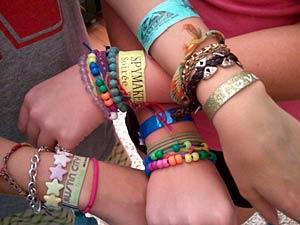
An overly strict music festival reentry policy can be a real point of contention among attendees, operators and local small business owners - as this post shows. Here's how to formulate a less strict, yet still profitable, festival reentry policy using barcoded wristbands and music festival ticketing software.
A festival’s reentry policy is just as important to attendees as it to the festival operator, but for different reasons. Festival goers want to be able to come and go without much hassle, especially on multi-day events. The reasons vary from trekking to an off-site camping area or to go see the sights in the town nearby. Attendees generally consider a strict “no ins and outs” policy to be a wet blanket on the fun.
Festival operators, on the other hand, see liberal reentry policies as a potential detriment to revenue (loss of concession and souvenir sales) not to mention a possible event security issue.
While nowhere near as controversial as ticket fees, festival reentry policies can be a point of contention. Take for example Mumford & Sons’ Gentlemen of the Road (GotR) music festival touring several cities around the world later this summer.
At issue is the strict “no ins and outs” reentry policy set by GotR which has local business owners up in arms. With more than 25,000 people expected at each of the festival’s host cities, the reentry policy stands in the way of untold millions in revenue for area small businesses and the host city itself.
One of the host city’s small business owners, Tony Leonard, finds the strict reentry policy unacceptable:
The festival is potentially a great event for the town, [but] pubs would suffer a loss of trade if festival goers aren't allowed to leave the Convent Field site at any time once they are admitted...If the festival is meant to be a celebration of [the city] and local business, then people really ought to be given the option of exploring the town during the day.
Mumford & Sons have offered to issue partial refunds to festival goers that want to leave the event early in order to go into town, but that isn't being met with much enthusiasm from business owners or ticket buyers. Negotiations between the area business owners and the Gentlemen of the Road music festival are on-going and described by an insider as being a "positive dialogue."
With a hint of mild irony, Mumford & Sons routinely goes on the record as saying they honor their fans wishes, first and foremost, yet such a strict reentry policy makes the GotR event less fun for attendees.
The time to plan your festival's reentry policy is before tickets go on sale, not after. Moreover, the reentry policy you set should be clearly presented to buyers, as seen in both the music festival ticketing software and on the physical tickets.
Avoiding as much legalese as possible will help ticket buyers know up front what they are, and are not, allowed to do as far as "ins and outs" are concerned. Having a clear and easy to understand reentry Policy of Truth, so-to-speak, will actually make a strict position more palatable.
Here are some examples of reentry policies that strike the right balance between happy patrons, happy festival operators and a safe, profitable music festival.
At the small to medium event scale, indoor venues hosting a music festival (or “battle of the bands”) often modify their standard reentry policy to accommodate the protracted amount of time such events usually take. For example, if an indoor venue has a solid eight hours of bands booked, it may not be practical to expect guests to be “trapped” inside for that long. The lineup appearance times may not match the fickle music fan, so they may prefer to be inside for a few hours, leave, then return later when their favorite band is playing.
If a strict no reentry policy simply must be maintained (ex: liability insurance constraints), a good practice is to publish the band line-up times well in advance on the venue website AND during the ticket purchase process.
As seen in the video above, outdoor music festivals can implement the latest in barcoded wristband technology and allow for a more lenient reentry policy.
Instead of choosing between “too strict” and "not strict enough", barcoded wristbands create a happy medium in reentry policies. The festival gates can be opened and closed, at intervals set by the festival operator, allowing patrons to leave and come back in a reasonable (and still profitable) manner.
Such a compromise would be perfect for the multi-day Gentlemen of the Road music festival mentioned earlier, since it would let people go into town later in the evening after the last band has finished performing.
You can avoid having to attend city council hearings, full of irate local business owners, by making barcoded wristbands the centerpiece of your festival's reentry policy. Doing so starts with your choice in music festival ticketing software.
The ThunderTix plan for music festivals features optional end-to-end, barcode gate control as part of our ticketing software. We are an industry leader in barcode technology and can scale barcoding systems to meet your specific needs. Print-at-Home barcoded tickets, thermal printing of barcode wristbands, and handheld scanners (which we sell and rent!) are just some of what we can offer you as you plan your reentry policy.
If you are interested in learning how we can help you plan your upcoming festival ticket sales and gate control methods, be sure to take a look at our other features and sign up for a free trial today!
Image source: Wiki Commons